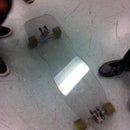Introduction: Hand Held Ballista
We are building a Torsion powered bow (Ballista) for our siege engine project. It is set up as a bullet crossbow, with the option of firing bolts with the use of a removable track. Our plan is to build it to fit within the specifications of our 18x18x18 size limit out of wood and string or modern elastic materials using the mill machine and laser. It will be assembled using a pin and glue system instead of bolts due to the historical nature of our project.
History
The Ballista is a Torsion weapon invented by the Greeks and widely used throughout the roman empire as a siege weapon. It survived through to the middle ages and was used along side Medieval siege weapons such as catapults and trebuchets. Its design is rather simple; It is two torsion springs made out of rope or sinew with the prods of the bow arm placed within them. Beyond this its mechanism is similar to the crossbow. The ballista uses a windlass to cock the mechanism and a quick release mechanism to fire the bow. It can be used to fire bolts or round shot.
Step 1: Materials
materials:
24"X48" "Handy panel" of MDF Particle Board
1/8" Braided nylon cord (48') (for torsion engines)
thin nylon cord (for bow string)
1/4" steel rod (36") X2
wood glue
1" diameter PVC Pipe
small piece of leather (for bullet pocket)
The material cost for this project is surprisingly low, hovering around the $25 mark for all building materials.
Tools:
Mill machine with travel of around 24"X48"
Shop vacuum
Solidworks 3D design software
Mastercam mill path/design software
set of hand files
hack saw with metal blade
Safety Gear:
goggles
gloves
Step 2: 3D Models
These are the 3D models saved in a downloadable zip file. The can be opened in Mastercam or a similar mill path design software for the production of mill paths.
Attachments
Step 3: Drawing Sheets
For those without Solidworks software or a mill machine, here are the drawing sheets for the parts used in this project. The whole project can be completed with hand tools and the common garage workshop. With a jigsaw, power drill, and router the whole project can be completed if you do not own a mill machine.
A basic guide for hand tools
Drill out all holes with a 1/4" drill bit
For pockets, drill a hole of a larger diameter than your jig saw blades width, then cut out the pocket with the jig saw
cut the parts out with the jig saw
Use a router to put the channel in the two body pieces
If you do not own a router, carve a path for the bolt track on each side with wood working tools
The first zip file contains the draft sheets saved as .SLDDRW for Solidworks and in .Jpg. The second zip file contains the draft sheets saved in .pdf
Attachments
Step 4: Making the Parts
Each part is designed to be milled out of 3/4" stock.
Design the mill paths based on the 3D models by opening the files in Mastercam and adding support geometry.
Mill multiple sets of the supports, as these parts are struck by the bow limb during firing and can fail over time.
Step 5: Assembly
Use the photos and the 3D model assembly to build your Ballista from the parts you have milled out.
The lock mechanism fits at the back of the crossbow. Follow the 3D assembly to build it. The remaining 2 3" pins go in the back 2 holes on the stock and the side plates of the lock slide over them. The 2 parts of the internal mechanism go inside and line up with the other two holes on the lock plate. The 2 parts of the trigger mechanism are held together by 2.25" pins.
Step 6: Bow Limbs
We chose to use PVC for its strength and lightness. The bow limbs have the most strain put on them in the system, so they must be strong, but they need to stay light so that the bow fires well. PVC pipe fits this need well.
Cut the 1" PVC pipe to two pieces approximately 10.75"
Use a hack saw, band saw, file, etc. to make a knock approximately .5" deep on one side of each bow limb.
Step 7: Torsioning the Bow
make 2 coils of nylon cord with 10 loops of cord that are of equal length. (A good length is around 7 inches) slide the coil through the circular hole in the top and bottom plates and put the tensioning pins through the coil on either side and place your bow limb in the center. turn the coils and equal number of times away from the body of the ballista on the top and bottom. The easiest way to torsion the crossbow is by attaching a vice grip to the pin. The pins going through the top and bottom plates of the bow keep the coils from untwisting. The coils should be of equal poundage if the length of the coils and number of turns are the same. 4 turns will raise the poundage to somewhere in the neighborhood of 35-45 pounds draw weight.
Step 8: Stringing the Bow
There are two types of bow string that can be used for the ballista; one for bolts and one for bullets. The bolt string is a piece of nylon cord with loops on either end. The bullet string is similar, but has a leather pocket for the projectile. Examples of these are shown in the pictures.
Step 9: Conclusion
The design work fine for both bullets and bolts. the MDF board held up well under tension, as did the cord used for the torsion engine and bow limbs. With a ball, the range is somewhere around 50 feet or more at a flat trajectory. We tested it with a bolt at a flat trajectory and it went a distance of greater than 100 feet before being obstructed (By a house.)
Attachments:
Video of ballista firing a bolt at target bag
video of ballista firing a rubber ball
video of ballista firing a bolt through a box. range distance- 40ft

Participated in the
Make It Real Challenge

Participated in the
Woodworking Challenge

Participated in the
Education Contest















